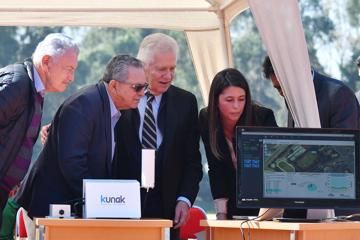World Athletics launches second phase of Air Quality project in Nairobi (© Roger Sedres)
World Athletics’ ground-breaking Air Quality project made a big leap forward with the Phase 2 launch of its research efforts in the Kenyan capital Nairobi on Tuesday (17).
As part of World Athletics’ pilot programme to measure and analyse air quality at sporting venues around the world, an air quality monitor was installed 18 months ago at Kasarani Stadium, the host venue of the World Athletics U20 Championships which get under way today (18). That installation, used primarily to assess the feasibility of maintaining high-end air quality devices in remote locales, paved the way for Tuesday's launch which will include the deployment of a wide range of technologies that will enable researchers to collect and analyse more data than ever before.
The potential of the Nairobi research is great, said Miguel Escribano, Business Development Director for Kunak, the manufacturer of the air quality monitoring devices, because it is often difficult for local authorities to pinpoint pollution sources and trends to develop effective solutions.
"Conventional air pollution management commonly relies on a few reference stations that are expensive and difficult to operate – and in mathematical modelling with high uncertainty,” Escribano said. “This new sensor technology is changing that dynamic, allowing us to measure and map pollution concentrations with more spatial resolution, targeting different concentrations inside and outside the stadium for example, and temporal resolution every 5 minutes instead of an hourly average.
"In that sense, the World Athletics initiative at Kasarani Stadium builds on previous efforts by UNEP, The Stockholm Environment Institute (SEI), the MIT Senseable City Lab, C40 and others, to deploy a dense network of sensors in Nairobi for a better understanding of health effects, and to identify and correlate the patterns with different activities and sources like never before."
The set-up this week includes a perimeter of 20 passive dosimeters at the stadium that will help map the area and detect potential hotspots. Two sensor-based stations have been installed in the warm-up area and at the stadium, just a few metres from where athletes generally gather, to collect data that will contribute to the Health and Science Department’s research on the correlation between air quality and performance. These hyperlocal monitoring stations are equipped with sensors to measure nitrous oxide, ozone and carbon monoxide, along with wind speed and direction and heat stress.
A mobile monitor will be transported in a vehicle around the site mapping hundreds of GPS coordinates to analyse potential changes in the spatial distribution of particles and gases. Also, a Black Carbon monitor and a particle counter will help researchers understand the size distribution of particles, their nature and origin, and how pollution relates to climate change. Additionally, a group of five volunteers will carry wristbands throughout the week to measure their personal exposure to volatile organic compounds.
“The air quality research we are conducting here is a continuation of the research activities we have carried out so far,” said Stephane Bermon, Director of the World Athletics Health and Science Department.
“The protocol applied here is very similar to the one we had in Yokohama in 2019. For the past three years we have been collecting data on air quality at indoor and outdoor athletics events. All this data allow us to better take into account the environmental conditions for our future competitions and thus preserve the health of our athletes.”
Athletics Kenya President Jackson Tuwei said: “Athletics Kenya is honoured that World Athletics has set out to conduct environmental research during the U20 Championships. We are looking forward to receiving the results and to learn from them.”
As part of its ongoing research into links between air quality and athletics performance, the Health and Science Department will be conducting a survey of athletes participating in the championships to better understand the correlation between air quality, performance and respiratory symptoms or conditions.
Athletes will also be surveyed on their attitudes about climate change and sustainability.
Combating air pollution and working to improve air quality is one of the six key pillars of the World Athletics Sustainability Strategy, a 10-year road map unveiled in April 2020 whose goals include transitioning to carbon neutrality across all of its operations and events by 2030.
More about the World Athletics Air Quality Project can be found here.







